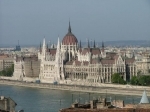 Budapest’s great Parliament building, completed in 1902, was built to the eclectic design of Imre Steindl. It mixes a predominant neo-Gothic style with a neo-Renaissance dome. Standing proudly on the Danube bank, visible from almost any riverside vantage point, it has been from the outset one of Budapest’s symbols, though until 1989 a democratically elected government had convened here exactly once (just after World War II, before the Communist takeover). Built at a time of extreme optimism and national purpose, the building was self-consciously intended to be one of the world’s great houses of Parliament, and it remains one of the largest state buildings in Europe. The main cupola is decorated with statutes of Hungarian kings. On either side of the cupola are waiting rooms leading into the respective houses of Parliament. The waiting room on the Senate side (blue carpet) is adorned with statues of farmers, peasants, tradesmen, and workers. The statues that decorate the waiting room on the representatives’ side (red carpet) are of sailors, soldiers, postal officials, etc. The interior decor is predominantly neo-Gothic. The ceiling frescoes are by Károly Lotz, Hungary’s best-known artist of that genre. Note the purportedly largest handmade carpet in Europe, from the small Hungarian village of Békésszentandrás. The Parliament is also home to the legendary crown jewels of St. Stephen, which were moved here from the National Museum in 2000, as part of the Hungarian millenium celebration.
Budapest’s great Parliament building, completed in 1902, was built to the eclectic design of Imre Steindl. It mixes a predominant neo-Gothic style with a neo-Renaissance dome. Standing proudly on the Danube bank, visible from almost any riverside vantage point, it has been from the outset one of Budapest’s symbols, though until 1989 a democratically elected government had convened here exactly once (just after World War II, before the Communist takeover). Built at a time of extreme optimism and national purpose, the building was self-consciously intended to be one of the world’s great houses of Parliament, and it remains one of the largest state buildings in Europe. The main cupola is decorated with statutes of Hungarian kings. On either side of the cupola are waiting rooms leading into the respective houses of Parliament. The waiting room on the Senate side (blue carpet) is adorned with statues of farmers, peasants, tradesmen, and workers. The statues that decorate the waiting room on the representatives’ side (red carpet) are of sailors, soldiers, postal officials, etc. The interior decor is predominantly neo-Gothic. The ceiling frescoes are by Károly Lotz, Hungary’s best-known artist of that genre. Note the purportedly largest handmade carpet in Europe, from the small Hungarian village of Békésszentandrás. The Parliament is also home to the legendary crown jewels of St. Stephen, which were moved here from the National Museum in 2000, as part of the Hungarian millenium celebration.
You can visit the parliament only in organized tours that take place every 30 – 60 minutes. Every major hotel (and travel offices of course) will be able to help you with tour arrangements. English tours: 10 a.m., 12 a.m. and 2 p.m. German tours: weekday 11 a.m. and 3 p.m., Sunday 11 a.m. French tours: 2 p.m. Russian tours: weekdays 3 p.m., Sunday 11 a.m. Hebrew tours: 10.30 a.m. and 1.30 p.m. Italian tours: weekdays 11.30 a.m. and 4 p.m., Sunday 11.30 a.m. Spanish tours: weekdays 11.30 a.m. and 4 p.m., Sunday 11.30 a.m. The parliament building today is not only a symbol of the newfound democracy but is also architecturally very impressive. It dominates a large part of the Danube riverfront.Phone: + (36) 1 441-4000
Directions: On Kossuth Lajos ter; metro M2, trams #2 2A, trolley-buses #70 78 and bus #15 to Kossuth Lajos ter stop
Website: http://www.parlament.hu/parl_en.htm
